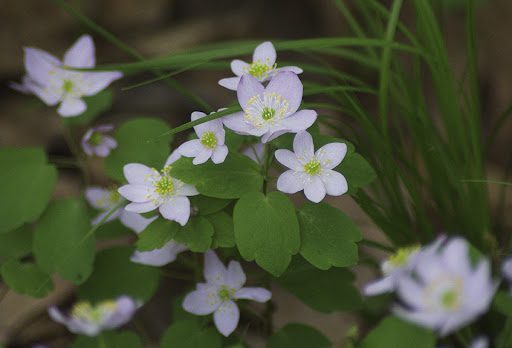Every spring, gardeners hold their collective breath as we wait for the first green shoots pushing through the warming soil. To be a perennial gardener in this climate requires great faith in your choices.
It seems miraculous that fragile perennial plants and very early blooming trees and shrubs can survive the onslaught of the weather extremes in our very fickle springs. And some of the most delicate and dainty-looking of them all, are really among the toughest and most tenacious plants in the garden. These are the natives of the woodland garden, our precious spring ephemerals.
The term ephemeral means fleeting or transitory. These wildflowers complete their life cycles in the short time period of one to two months. Between the time that the snow melts and the trees begin to leaf out, they must emerge, flower, be pollinated and produce seeds before the forest floor becomes too shaded. Many people miss this spectacular event because the ephemerals often bloom in cold, wet weather and keep a low profile. Those of us who know better, are often found giddily crawling around on the ground to get a closer look at these amazing blossoms.
One of the earliest blooming is bloodroot, Sanguinarea canadensis, named for the red-orange sap that flows from broken roots and stems. Emerging in April, the white daisy-shaped flowers poke through the ground, cloaked in pale green leaves. As the flower opens, the leaf unfurls to show off its intricate shape. Bloodroot flowers last just a few days, so watch for it, and appreciate their short-lived glory. The foliage then dies back quite quickly as the weather warms.
Perhaps the most recognized spring woodland wildflower is the trillium. The large, showy flowers are white, red or yellow depending on the species. Wake Robin is a common name as Trillium begin to flower when robins arrived in spring. Of course, robins hang around all winter in some areas now. And I am excited when I see them congregating on grassy terraces. Trilliums are a slow-growing, so be patient if you are trying to introduce them to your garden. It may take a few years before they bloom, and another few before they start to multiply. Once they get established they are very long-lived and will grace the site forever.
Trilliums prefer deciduous forests where they will get the early spring sun. Choose a spot that has soil rich in organic matter and is moist, but still drains well. Planting depth for a rhizome is about two inches deep. Water after planting and then forget about it. No fertilizing, no dividing, no fuss.
Another plant that I dearly love is the Rue Anemone, Anemonella thalictroides. These sturdy little plants will bloom their hearts out for you, often flowering for a couple months in years when the summer doesn’t heat up too quickly. The dainty foliage looks like true Rue but is held aloft on wiry stems that dance with the spring breezes. Flowers bloom pure white and turn a lovely pale pink as they age. I don’t consider Rue Anemone a true ephemeral as the foliage is persistent and lasts throughout the growing season, but it blooms early, so I’m including it.
I appreciate as large a plant palette as I can possibly manage, but any exotic, or non-native plants should be used thoughtfully when you introduce them to spaces planted with ephemerals. There are many species, both woody and herbaceous, that have become quite a nuisance, and a few that are downright thugs. As garlic mustard, purple loosestrife and other invasive plants move in and take over native habitats, we are losing populations of our precious wildflowers. Please learn to identify invasive species and do what you can to stop their spread. The Madison area has a chapter of The Wild Ones, a group that is a trove of information. They often organizes volunteer work parties to remove invasive species in sensitive sites. A couple of my favorite identification resources are the Peterson Field Guide to Wildflowers and the locally produced Spring Woodland Wildflowers of the University of Wisconsin-Madison Arboretum. My copies are tattered almost beyond recognition. And don’t forget that you can check in with the Plant Information Desk in the Garden Center by sending photos to identify or to ask questions at plantdesk@brucecompany.com

